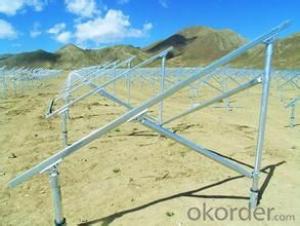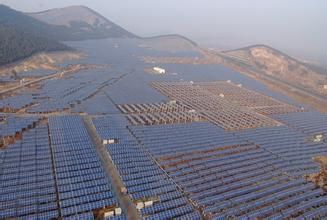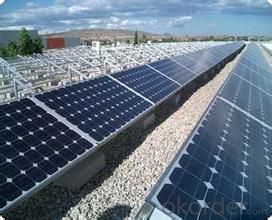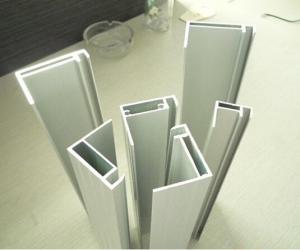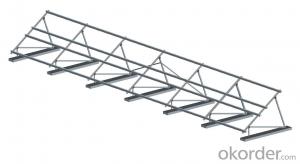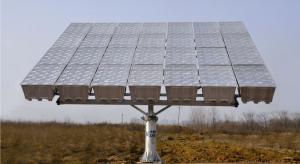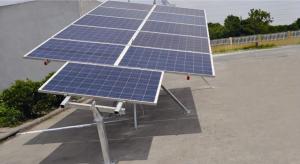K2 Mounting Systems Solar FS Mounting System
- Loading Port:
- China Main Port
- Payment Terms:
- TT OR LC
- Min Order Qty:
- -
- Supply Capability:
- -
OKorder Service Pledge
OKorder Financial Service
You Might Also Like
Solar Mounting System
Die Schletter Freilandsysteme zeichnen sich durch minimale Montagezeit,
lange Lebensdauer und hohe Wirtschaftlichkeit aus. Anhand vorgegebener Projektdaten - länderspezifischer Normen und Vorgaben - berechnen wir für Sie die komplette Statik und
erstellen einen lückenlosen Projektplan. Dies garantiert eine verlässliche Standsicherheit und
hohe Ausfallsicherheit.
Maximaler Vorfertigungsgrad
Keine Bodenversiegelung
Schnelle und einfache Montage
Perfekt aufeinander abgestimmte Systemkomponenten
Hohe Wirtschaftlichkeit
System mit Rammfundamentierung
Optimierte projektbezogene Planung
Ausgezeichnete Materialeffizienz, bis ins Detail optimierte Systemanschlüsse
Systemkomponenten aus Stahl
- Q: Can a solar mounting system be used in areas with solar rebates for businesses?
- Yes, a solar mounting system can definitely be used in areas with solar rebates for businesses. In fact, it is highly recommended to utilize a solar mounting system in such areas as it helps maximize the efficiency and effectiveness of the solar panels, thereby increasing the potential benefits and savings from the solar rebates.
- Q: Can a solar mounting system be installed on a rooftop with a BUR roof?
- Yes, a solar mounting system can be installed on a rooftop with a Built-Up Roof (BUR). However, it is important to consult with a professional installer or engineer to ensure that the roof structure can support the additional weight of the solar panels and mounting system. Additionally, proper waterproofing and flashing techniques must be implemented to prevent any potential leaks or damage to the BUR roof.
- Q: Are there adjustable solar mounting systems available?
- Yes, there are adjustable solar mounting systems available. These systems allow for the adjustment of the angle and orientation of solar panels to optimize their performance and maximize energy production.
- Q: Specification for installation of fire pipe support
- The diameter of the hole on the bracket is 1 ~ 2mm larger than the diameter of the bolt. The burr on the bracket should be polished in time, and the end of the bracket should be chamfered
- Q: Can a solar mounting system be used in areas with unstable power grids?
- Yes, a solar mounting system can be used in areas with unstable power grids. Solar mounting systems are designed to function independently from the power grid, relying solely on the energy generated from sunlight. This allows them to provide a stable and reliable source of electricity even in areas with inconsistent or unreliable power supply. Additionally, solar systems can also incorporate battery storage solutions to store excess energy generated during peak sunlight hours, further enhancing their ability to operate in areas with unstable power grids.
- Q: Can a solar mounting system be installed on a mountain or ski resort?
- Yes, a solar mounting system can be installed on a mountain or ski resort. In fact, these locations often have ample sunlight exposure, making them ideal for solar energy generation. Mounting systems can be designed to withstand the unique challenges of mountainous terrain, ensuring the installation is secure and efficient.
- Q: Are there any specific requirements for installing a solar mounting system on a floating platform?
- Yes, there are specific requirements for installing a solar mounting system on a floating platform. These requirements include ensuring that the platform is stable and can support the weight of the solar panels, designing the mounting system to withstand wind, wave, and water pressure forces, using corrosion-resistant materials to withstand the marine environment, and ensuring proper electrical connections and grounding. Additionally, the mounting system should be designed to allow for easy maintenance and cleaning of the solar panels.
- Q: Can a solar mounting system be installed on a pergola or shade structure?
- Yes, a solar mounting system can be installed on a pergola or shade structure. These structures provide an ideal platform for mounting solar panels as they offer sufficient space and support. Additionally, the pergola or shade structure can provide shade to the panels, which can improve their efficiency by preventing overheating.
- Q: How much does a solar mounting system cost?
- The cost of a solar mounting system can vary depending on several factors such as the size of the system, type of mounting system, and the specific requirements of the installation. On average, a solar mounting system can range from a few hundred dollars for smaller residential systems to several thousand dollars for larger commercial installations.
- Q: What are the advantages of using a solar mounting system?
- There are several advantages of using a solar mounting system. Firstly, it allows for the optimal positioning and angle of solar panels, maximizing their exposure to sunlight and thus increasing energy production. Additionally, solar mounting systems provide stability and protection for the panels, ensuring their longevity and efficiency. They also simplify the installation process and allow for easy maintenance and cleaning. Moreover, solar mounting systems can be customized to fit various types of roofs and terrains, making them versatile and adaptable. Finally, using a solar mounting system can increase the overall value of a property and contribute to a more sustainable and eco-friendly energy solution.
Send your message to us
K2 Mounting Systems Solar FS Mounting System
- Loading Port:
- China Main Port
- Payment Terms:
- TT OR LC
- Min Order Qty:
- -
- Supply Capability:
- -
OKorder Service Pledge
OKorder Financial Service
Similar products
Hot products
Hot Searches
Related keywords

